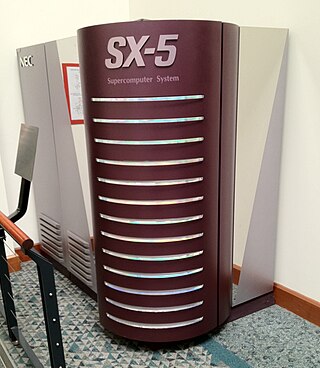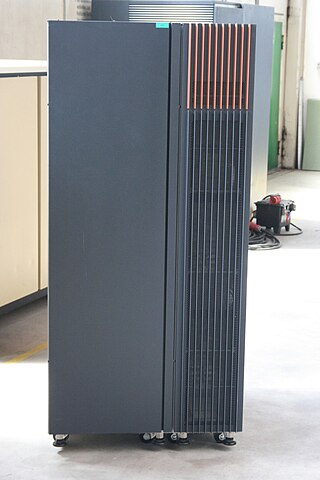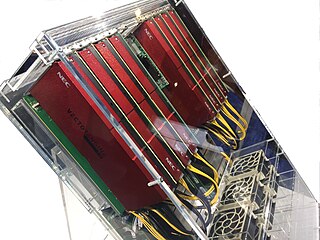In computing, a vector processor or array processor is a central processing unit (CPU) that implements an instruction set where its instructions are designed to operate efficiently and effectively on large one-dimensional arrays of data called vectors. This is in contrast to scalar processors, whose instructions operate on single data items only, and in contrast to some of those same scalar processors having additional single instruction, multiple data (SIMD) or SWAR Arithmetic Units. Vector processors can greatly improve performance on certain workloads, notably numerical simulation and similar tasks. Vector processing techniques also operate in video-game console hardware and in graphics accelerators.
The Earth Simulator (ES) is a series of supercomputers deployed at Japan Agency for Marine-Earth Science and Technology Yokohama Institute of Earth Sciences.

Blue Gene is an IBM project aimed at designing supercomputers that can reach operating speeds in the petaFLOPS (PFLOPS) range, with low power consumption.
Cray Inc., a subsidiary of Hewlett Packard Enterprise, is an American supercomputer manufacturer headquartered in Seattle, Washington. It also manufactures systems for data storage and analytics. Several Cray supercomputer systems are listed in the TOP500, which ranks the most powerful supercomputers in the world.
Cell is a 64-bit multi-core microprocessor microarchitecture that combines a general-purpose PowerPC core of modest performance with streamlined coprocessing elements which greatly accelerate multimedia and vector processing applications, as well as many other forms of dedicated computation.
The Fujitsu FACOM VP is a series of vector supercomputers designed, manufactured, and marketed by Fujitsu. Announced in July 1982, the FACOM VP were the first of the three initial Japanese commercial supercomputers, followed by the Hitachi HITAC S-810 in August 1982 and the NEC SX-2 in April 1983.
SUPER-UX was a version of the Unix operating system from NEC that is used on its SX series of supercomputers.

NEC SX describes a series of vector supercomputers designed, manufactured, and marketed by NEC. This computer series is notable for providing the first computer to exceed 1 gigaflop, as well as the fastest supercomputer in the world between 1992–1993, and 2002–2004. The current model, as of 2018, is the SX-Aurora TSUBASA.

The R10000, code-named "T5", is a RISC microprocessor implementation of the MIPS IV instruction set architecture (ISA) developed by MIPS Technologies, Inc. (MTI), then a division of Silicon Graphics, Inc. (SGI). The chief designers are Chris Rowen and Kenneth C. Yeager. The R10000 microarchitecture is known as ANDES, an abbreviation for Architecture with Non-sequential Dynamic Execution Scheduling. The R10000 largely replaces the R8000 in the high-end and the R4400 elsewhere. MTI was a fabless semiconductor company; the R10000 was fabricated by NEC and Toshiba. Previous fabricators of MIPS microprocessors such as Integrated Device Technology (IDT) and three others did not fabricate the R10000 as it was more expensive to do so than the R4000 and R4400.

The SX-8 is a supercomputer built by NEC Corporation. The SX-8 Series implements an eight-way SMP system in a compact node module and uses an enhanced version of the single chip vector processor that was introduced with the SX-6. The NEC SX-8 processors run at 2 GHz for vectors and 1 GHz for scalar operations. The SX-8 CPU operates at 16 GFLOPS and can address up to 128 GB of memory. Up to 8 CPUs may be used in a single node, and a complete system may have up to 512 nodes. The SX-8 series ranges from the single-CPU SX-8b system to the SX-8/4096M512, with 512 nodes, 4,096 CPUs, and a peak performance of 65 TFLOPS. There is up to 512 GB/s bandwidth per node. The SX-8 runs SUPER-UX, a Unix-like operating system developed by NEC.
ViVA is a technology from IBM for coupling together multiple scalar floating point units to act as a single vector processor. Certain computing tasks are more efficiently handled through vector computations where an instruction can be applied to multiple elements simultaneously, rather than the scalar approach where one instruction is applied to one piece of data at a time. This kind of technology is highly sought after for scientific computing and is IBM's answer to the vector-based supercomputers pioneered by Cray and that was the basis for NEC's Earth Simulator which was the fastest supercomputer in the world 2002-2004.

The SX-9 is a NEC SX supercomputer built by NEC Corporation. The SX-9 Series implements an SMP system in a compact node module and uses an enhanced version of the single chip vector processor that was introduced with the SX-6. The NEC SX-9 processors run at 3.2 GHz, with eight-way replicated vector pipes, each having two multiply units and two addition units; this results in a peak vector performance of 102.4 gigaFLOPS. For non-vectorized code, there is a scalar processor that runs at half the speed of the vector unit, i.e. 1.6 GHz. Up to 16 CPUs and 1 terabyte of memory may be used in a single node. Each node is packaged in an air-cooled cabinet, similar in size to a standard 42U computer rack. The SX-9 series ranges from the single-node SX-9/B system with 4 CPUs to the maximum expansion stage with 512 nodes, 8,192 CPUs, and 970 TFLOPS peak performance. There is up to 4 TB/s shared memory bandwidth per node and 2×128 GB/s node interconnect bandwidth. The operating system is NEC's SUPER-UX, a Unix-like OS.
SiCortex was a supercomputer manufacturer founded in 2003 and headquartered in Clock Tower Place, Maynard, Massachusetts. On 27 May 2009, HPCwire reported that the company had shut down its operations, laid off most of its staff, and is seeking a buyer for its assets. The Register reported that Gerbsman Partners was hired to sell SiCortex's intellectual properties. While SiCortex had some sales, selling at least 75 prototype supercomputers to several large customers, the company had never produced an operating profit and ran out of venture capital. New funding could not be found.
The SPARC64 V (Zeus) is a SPARC V9 microprocessor designed by Fujitsu. The SPARC64 V was the basis for a series of successive processors designed for servers, and later, supercomputers.
The HITAC S-820 is a family of vector supercomputers developed, manufactured and marketed by Hitachi. Announced in July 1987, it was Hitachi's second supercomputer, succeeding the HITAC S-810. The S-820 is categorized as a second generation Japanese supercomputer.
Zero ASIC Corporation, formerly Adapteva, Inc., is a fabless semiconductor company focusing on low power many core microprocessor design. The company was the second company to announce a design with 1,000 specialized processing cores on a single integrated circuit.

Japan operates a number of centers for supercomputing which hold world records in speed, with the K computer becoming the world's fastest in June 2011. and Fugaku took the lead in June 2020, and furthered it, as of November 2020, to 3 times faster than number two computer.

The SX-ACE is a vector NEC SX supercomputer from NEC Corporation. It features NEC's first multi-core vector System on a Chip design, with four cores. The SX-ACE runs at 1 GHz, has peak performance of 64 GFLOPS per core, and has 64 gigabytes per second of memory bandwidth per core. Four cores make up a shared-memory node, and 64 nodes can fit in a rack for a total performance of 16 TFLOPS per rack. The SX-ACE was released in 2013. NEC released the successor, the SX-Aurora TSUBASA in 2017. It is used by Earth Simulator 3.
SUPRENUM was a German research project to develop a parallel computer from 1985 through 1990. It was a major effort which was aimed at developing a national expertise in massively parallel processing both at hardware and at software level.

The NEC SX-Aurora TSUBASA is a vector processor of the NEC SX architecture family. Unlike previous SX supercomputers, the SX-Aurora TSUBASA is provided as a PCIe card, termed by NEC as a "Vector Engine" (VE). Eight VE cards can be inserted into a vector host (VH) which is typically a x86-64 server running the Linux operating system. The product has been announced in a press release on 25 October 2017 and NEC has started selling it in February 2018. The product succeeds the SX-ACE.








